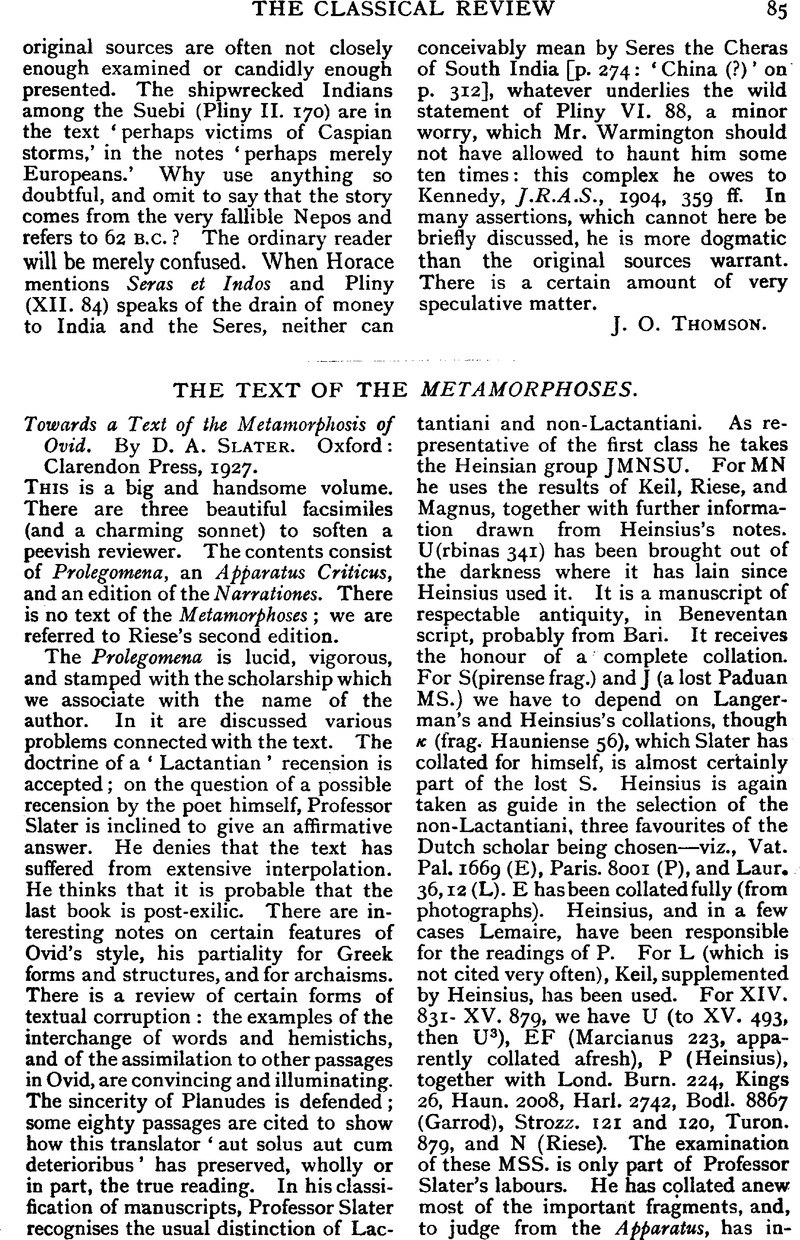No CrossRef data available.
Published online by Cambridge University Press: 27 October 2009

page 86 note 1 In Book III. this MS. (Laur. 36, 5 ?) is cited seventeen times. It does not seem to merit such honour. In nine cases the reading is in M or N or both. In four cases its readings seem peculiar to itself—namely, ‘125 plaudebant, 187 obstitit, 216 uel subducta, 453 nimium est.’
page 86 note 2 See Prolegomena on the Urbinas, Palatinus ueterrimus, Strozziani, Twisdenianus, Vossianus alter, fragmentum Boxhornianum, Berneggerianus. Obrecht, by the way, who parted with this last manuscript to the Royal Library of France, was something more than a ‘bibliopola nescio quis’ (p. 24).
page 86 note 3 In a wild moment it seemed a possible reference to Harl. 2610, which Schanz3 (p. 318) describes as ‘fragm Oxoniense eines Harleianus.’ Magnus similarly talks of ‘ein cod. Harleianus aus der Bodleiana zu Oxford’ (Studien zur Ueberlieferung, usw., II., p. 629).
page 86 note 4 Some of these are described by Magnus, Praef., p. xxiv. The papers touching the Tristia are mentioned by Merkel in the Preface to his Reimer edition. It has, if I am not mistaken, the excerpta Kloekhovii (pp. 318, 319) and the excerpta Scaligeri (p. 378).
page 87 note 1 If one looks at Chatelain's facsimiles of M and F (pls. 96 and 98), covering IX. 395–435, one notes that Professor Slater omits ‘397 numine M1, 411 fatale e.u.l. M2,’ and all reference to F (which he does not profess to use for this portion), while Magnus misrepresents M in ‘405 flebantque, 417 facietque’ (ex sil.), and F in ‘404 Capaneusque nisi, 413 hos, 417 effecitque.’ It would be unfair to suggest that such errors are frequent in the work of either scholar.
page 87 note 2 One should combine the material preserved in the Bodleian with that of Berlin, particularly MSS. (Impr.) Diez B. Sant. 1069, 1072, 1075 (there is practically nothing in 1078). These volumes are copies of the 1629 Elzevir, interleaved with quarto sheets. They are far more legible than the Bodleian copies, but are poorer as regards collations. Some of the collations overlap with those in the Bodleian; n. 1075, for instance, contains: ‘A codex Regius ante quingentos annos scriptus. B codex Regius in quo omnia Ovidii. C codex Thuani ante 400 annos scriptus. D codex alter Thuani non valde antiquus. E codex Regius tertius recens. F codex meus membraneus quem Carolus Sprottius dono dedit [now in Oxford=Bodl. Auct. F. 4. 22’. G codex Florentinus sci Marci. H codex Neapoli sci Joannis Carbonarii. I codex Urbinas a Langermanno collatus. K codex Bemeggeri Argentoratensis.’
page 88 note 1 It has many of the typical X readings (see on V. 558, IX. 718, X. 169, 493, XII. 465. XIII. 464, 607, XIV. 254, 421), and it has VIII. 87, 340–402, XIII. 849, which are omitted in O. The fact that the Narrationes do not extend into Book XV., though U is preserved as far as 493, supports this conclusion.